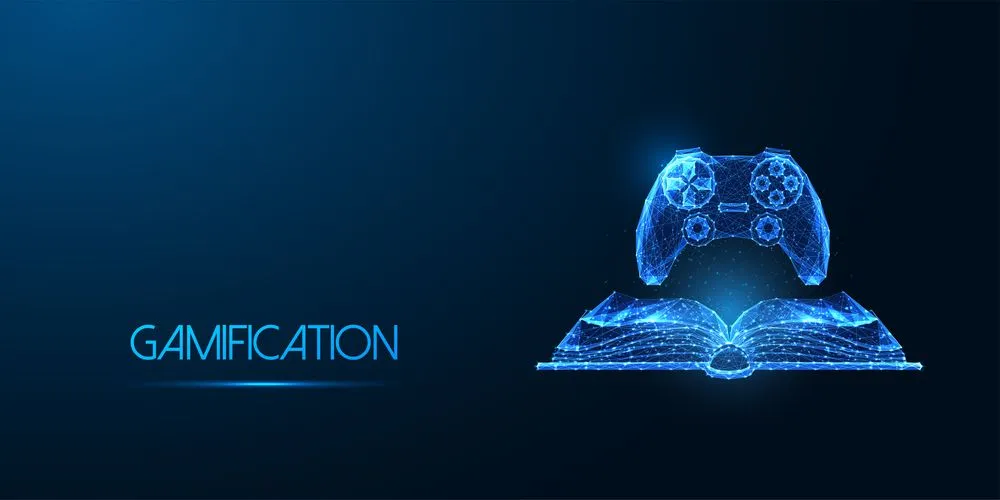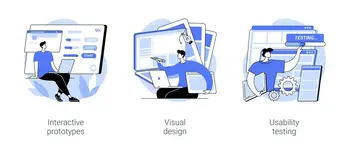
Table of contents
In today’s business environment, companies are using gamification to boost engagement in order to make things more fun and interesting by adding game-like elements. This can be used in many different places, like school or marketing.
In school, the effectiveness of gamification in the engagement of students can not be overstated. For example, teachers can give students points for completing assignments or quizzes. Students can also track their progress on a leaderboard. This can help students stay motivated and engaged in their learning.
Gamification in marketing boosts engagement and can be used to get people interested in a product or service. For example, a company might offer rewards for people who sign up for their email list or share their products on social media. This can help companies get more customers and keep them coming back. A study published in
ScienceDirect
found that gamification increases engagement. The study also found that more and more app developers are using gamification in their products.
An
article
on Edutopia said that gamification can help students learn by encouraging active learning, increasing attention span, and reducing stress. An article by
Userpilot
said that gamification marketing can be used to engage customers directly or increase user engagement through the addition of game dynamics.
What is Gamification?

1. Definition
Gamification is when you make something like a game to make it more fun and engaging. This could include things like earning points, badges, or rewards for completing tasks or challenges. Leaderboards are often a part of gamification, where people can see how they’re doing compared to others and try to get to the top of the list. It’s like turning something into a competition to make it more exciting and motivating.
2. Examples
A school might, for example, use gamification to make learning more fun by giving students badges for completing assignments, or by letting them earn virtual currency that they can use to buy rewards. A
study
found that 80% of students would retain more of what is taught if gamification was used as a tool in their lessons.
At the gym, gamification helps people exercise more. Apps like Nike Training Club and Fitbit use games to help people reach their fitness goals. A
study
found that gamification can increase physical activity by 27%.
In addition, social media platforms like Facebook and Instagram use gamification to encourage users to post more content, interact with their friends, and stay active on the platform. For example, Facebook gives users points for liking and sharing posts, and Instagram lets users earn badges for completing certain challenges.
Furthermore, there are many learning apps that use gamification to make learning more fun and engaging. For example, the app Duolingo uses a points system to track your progress, and it lets you earn rewards for completing lessons.
In stores, gamification helps people buy more stuff. Brands like McDonald’s and Starbucks use games to get people to come back and buy more. A
study
found that gamification can increase customer engagement by up to 50%.
Gamification is a powerful tool that can make things more fun and engaging. By using game mechanics in real-world activities, gamification can make boring tasks more enjoyable.
Gamification and Engagement

Gamification can be an effective technique for increasing engagement. When people are engaged in an activity, they are more likely to be motivated to continue participating. Gamification can increase engagement by:
-
Making tasks more enjoyable: When you add gamification elements to a task, you’re making it more fun and interesting. This can help people stay engaged and motivated to keep going, even if the task is challenging or boring.
-
Creating a sense of accomplishment: When people earn points, badges, or rewards for completing tasks, they feel a sense of accomplishment. This can motivate them to keep going and strive to do even better.
-
Fostering competition: Leaderboards and other competitive elements can motivate people to try harder and do better. When people see how they’re doing compared to others, they may be more motivated to push themselves to the top of the leaderboard.
-
Increasing retention: When people are engaged and motivated, they’re more likely to remember what they’ve learned or experienced. This can lead to better retention of information and skills.
Overall, gamification can be a powerful tool for increasing engagement and motivation. When you make tasks more enjoyable, create a sense of accomplishment, and foster competition with gamification, your audience is likely to stay engaged and motivated to achieve their goals.
Tips for using gamification to increase engagement:
-
Make sure the game elements are relevant to the activity. The game elements should be something that the participants will find interesting and motivating. Game elements can include points, levels, challenges, rewards, and competition. The key is to choose elements that are appropriate for the activity and that will appeal to the participants.
-
Keep the game simple. The game should be easy to understand and play, so that people don’t get frustrated.
-
Offer rewards that are meaningful to the participants. The rewards should be something that the participants will actually want, such as badges, prizes, or access to exclusive content.
-
Track progress and provide feedback. Participants should be able to track their progress and see how they are doing. This will help them stay motivated and engaged.
-
Make the game challenging but achievable. The game should be challenging enough to be interesting, but not so challenging that it’s frustrating.
-
Promote competition. Competition can be a great way to motivate people to strive for excellence.
If you follow these tips, you can use gamification to create engaging and motivating experiences that will keep people coming back for more.
How to Implement Gamification

If you want to use gamification to boost engagement, you need to first decide what you want to achieve. Then, you will need to choose the right game-like elements for your goal. Finally, you need to set up a system for tracking progress and rewarding paricipants. Here are the steps to get started:
1. Identify Objectives
Before you start making a game-like program, you need to know what you want to do with it. Do you want to encourage employees to complete certain tasks, motivate customers to make a purchase, or help people learn better? Once you know what you want to do, you can start thinking about how a game-like program can help you do it.
A study by
TalentLMS
found that 83% of people who used a game-like program said that it made them more productive, and 61% said that it made them more engaged. These numbers show that game-like programs can have a big impact on how people work and learn.
2. Choose Game Elements
Once you know what you want to achieve, you can pick game parts to help you. Game elements may include things like points, badges, levels, and leader boards. You need to pick game elements that are important to your goals and that will make your target audience want to do what you want them to do.
If, for example, your objective is to get students to complete more lessons, or to participate more in discussions, you could have the following elements:
- Points: Students could earn points for completing lessons, participating in discussions, or answering quizzes correctly.
- Levels: Students could level up as they earn more points.
- Challenges: Students could complete challenges to earn bonus points or rewards.
- Rewards: Students could earn rewards, such as badges, for completing challenges or reaching certain goals.
- Competition: Students could compete with each other on a leaderboard to see who can earn the most points.
3. Design Game Mechanics
Once you choose your gamification elements, you need to make the rules and systems that make your gamification program work. The rules and systems are called game mechanics. You need to make game mechanics that are easy to understand and that make your target audience want to play.
For example, if you are using points, you need to decide how many points learners will get for finishing modules and how many points they need to get to reach the next level. If you are using a leaderboard, you need to decide how often it will be updated and what things will be used to rank learners.
4. Build the Game
Whether you are a seasoned developer or a beginner, there are a variety of tools and platforms available to help you create a game that meets your needs and fits your skill level.
If writing code is not your cup of tea, one popular tool is
Gamify
. Gamify is a web-based platform that allows you to create games without any coding knowledge. It includes a drag-and-drop interface that makes it easy to create game mechanics, add graphics and sound effects, and publish your game to your website. Gamify also includes a variety of pre-built templates and game mechanics, making it easy to get started and create a game that is engaging and fun.
For those who are happy writing code, there are a variety of game engines and frameworks available that provide more flexibility and customization options. Some popular game engines include
Unity
or
Unreal Engine
and
Godot
. These engines allow you to create games for a variety of platforms, including desktop, mobile, and console, and provide a wide range of tools and features for creating complex and engaging games.
In addition to game engines, there are also a variety of libraries and frameworks available for building games with web technologies such as HTML, CSS, and JavaScript. Some popular libraries and frameworks include Phaser, Three.js, and Pixi.js. These libraries provide a variety of tools and features for creating 2D and 3D games, and are often used in combination with other web technologies such as WebGL and Canvas.
However, not everyone has the time or expertise to learn how to develop games for their websites. That’s why we, at Interactivity Hub offer a range of services that can help you create the perfect game for your needs, without the hassle of learning how to do it yourself.
Our team can work with you to identify your goals and objectives, and create a game that meets your needs and fits your budget. We use a variety of tools and platforms, including Gamify, Adobe Animate, and other game engines and frameworks, to create games that are engaging and fun.
5. Test and Refine
After creating your game, test it with a small group of people and gather feedback. This feedback can help you identify any issues or areas for improvement, and make changes to your game accordingly.
During the testing phase, it’s important to track metrics like engagement, completion rates, and user feedback. This can help you determine how effective your game is at achieving your goals, and identify any areas that need improvement.
Once you’ve gathered feedback and made changes to your game, it’s important to continue testing and refining. This can involve testing with larger groups of people, gathering more feedback, and making additional changes as needed.
In conclusion, gamification can be a powerful way to make people more interested and help you reach your goals. By following the steps outline, you can make a gamification program that motivates your target audience to play and may help you reach your goals. According to a study by
Gartner
, gamification can lead to a 50% increase in engagement metrics for businesses that use it correctly. These statistics show how gamification can affect engagement and productivity.
Measuring the Success of Gamification

Gamification can help audiences to stay engaged and motivated. But to know if gamification is working, it is important to measure its success. This can be done by using different metrics and analytics.
A. Metrics
Metrics are quantitative measurements that can help determine the impact of gamification on engagement and motivation. These metrics can include:
- Participation rates: How many users are participating in the gamified activity?
- Completion rates: How many users are completing the gamified activity?
- Time spent: How much time are users spending on the gamified activity?
- Scores: What are the scores of users in the gamified activity?
- Feedback: What feedback are users providing about the gamified activity?
Game creaters can see how well gamification works by watching numbers. For example, if participation rates are low, it may be an indication that the game is not engaging enough and needs to be revised. If completion rates are high, it may be an indication that the game is effective at motivating users to complete tasks. By tracking metrics like these, game creators can gain valuable insights into the effectiveness of their gamification efforts.
B. Analytics
Gamification is when you use game-like features in non-game content. Analytics is how you measure how well gamification works. There are three kinds of analytics:
- User behaviour: How are people using the gamified element?
- User sentiment: What do people say about the gamified element?
- User retention: How many people keep using the gamified element?
By looking at these analytics, people can learn how gamification works. For example, if user behaviour analytics show that users are spending more time on the gamified element than on non-gamified elements, it may be an indication that the game is effective at increasing engagement. If user sentiment analytics show that users are providing positive feedback about the gamified element, it may be an indication that the game is effective at motivating and engaging users. By analyzing these types of analytics, game creators can gain a deeper understanding of how their gamification efforts are impacting their audience and make data-driven decisions about how to improve their game.
Challenges in Gamification
Gamification has been used in a lot of different fields, like education, marketing, and healthcare. It can be a really effective way to get people engaged, but it’s not always easy to do well. There are a few challenges that designers and users face when implementing gamification. One challenge is figuring out what kind of game elements will be most effective. Another challenge is making sure that the gamification doesn’t get too complicated or overwhelming.
(a) Design Challenges
Gamification is hard. It’s hard to make a game that is both fun and educational. Designers have to think about the people who will be playing the game, and what they want to learn. They also have to make sure that the game mechanics are helpful, and not just distracting.
One
study
found that 80% of gamification projects fail because they are not well-designed. This shows how important it is to get the design right.
(b) User Challenges
Another problem is that people might not be motivated to keep playing if the rewards aren’t good enough. In addition, gamification might not be accessible to everyone, especially people with disabilities.
A study by TalentLMS found that 83% of employees liked gamified training better than traditional training. But only 61% of employees thought gamified training was more effective. This means that gamification can be fun, but it might not always be the best way to learn.
Future of Gamification

(i) Emerging Trends
Gamification is a way to make things more fun and interesting by using game-like elements. It has been around for a while, but it is getting more popular. In fact,
the gamification market is expected to be worth $58.71 billion by 2027
. There are a few new trends in gamification that are changing the way we think about it. One trend is the use of virtual and augmented reality. These technologies let people experience things in a more realistic way, which makes gamification more engaging. For example, a virtual reality game could let you practice driving a car or flying a plane.
Another trend is the use of artificial intelligence (AI) in gamification. AI can personalize the gamification experience for each person, which makes it more relevant and engaging. For example, an AI-powered gamification platform could track your progress and give you personalized challenges to help you reach your goals. Gamification is a powerful tool that can be used to motivate people to do things they might not otherwise do. It is also a great way to learn new things and have fun. The future of gamification is very exciting, and I can’t wait to see what new trends emerge.
(ii) Predictions
The future of gamification is bright. People think it will become more a part of our everyday lives. For example, fitness apps might use gamification to make people want to work out more. Shopping apps might use gamification to give people rewards for buying things.
Another prediction is that gamification will become more social. This means that people will be able to compete with their friends and family. This makes the experience more fun and exciting. For example, a language learning app might let people compete with their friends to see who can learn the most words in a week.
Conclusion
Gamification is a way to make things more fun and exciting by adding game-like elements. This can be done in different areas, like education and marketing. For example, a gamified marketing campaign might give people points for completing tasks, like signing up for a newsletter or sharing a post on social media. This can help to keep people engaged and motivated.
There is research that shows that gamification can be effective. For example, a study by
Bitrián et al. (2021)
found that gamification can increase customer engagement and willingness to pay. Another study, by
Layth et al. (2020)
, found that gamified education can help students learn better.
However, it’s important to remember that gamification doesn’t always work. The success of gamification depends on a number of factors, like the target audience, the activity being gamified, and the specific game-like elements used. That’s why it’s important to carefully consider these factors when designing a gamification strategy.
In conclusion, gamification can be a valuable tool for increasing engagement, but it needs to be used in the right way. By carefully considering the context and audience, you can maximize the benefits of gamification.














